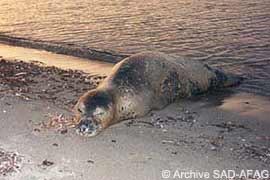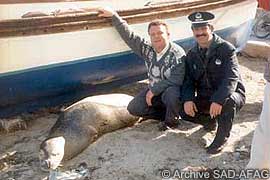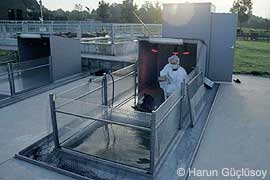

 |
||
 |
||
Vol. 6 (1): June 2003 |
Download this article
|
|
IS THE REHABILITATION OF THE MEDITERRANEAN MONK SEAL MONACHUS MONACHUS (HERMANN 1779) IN TURKEY NECESSARY?Harun Güçlüsoy, Hasan Örek and N. Ozan VeryeriUnderwater Research Society – Mediterranean Seal Research Group (SAD-AFAG)
|
 |
|
|
Fig. 1. A stranded and ailing monk seal on the Turkish coast in 1999. The individual subsequently died. |
The Conservation Guidelines were subsequently endorsed by 78 marine mammalogists and other professionals involved in the study and conservation of the monk seal.
The purpose of the authors in the present study is to discuss whether a permanent rehabilitation centre for the Mediterranean monk seal is required in Turkey, and to determine the measures, precautions and organisation that would be required to handle effectively potential cases of rehabilitation.
This study was based on information gathered from scientific papers and grey publications on the rehabilitation of the Mediterranean monk seal, and on experience gained by the authors while working at the Seal Rescue and Rehabilitation Centre (SRRC) in the Netherlands.
In the Mediterranean Monk Seal – Conversation Guidelines (Johnson and Lavigne 1998), measures and precautions to be considered for the rescue and rehabilitation of the species were listed as follows:
Rehabilitation of Mediterranean monk seals began in 1987 when 2 orphaned pups were found in Greece (Hart and Vedder 1990). Rehabilitation efforts have subsequently continued in Greece, Mauritania and in Madeira, Portugal (Table 1).
|
State |
Population Estimate |
Rehabilitation |
Released |
Source |
|
Greece |
200 – 250* |
11+2 |
6+? |
Androukaki et al., 1999 |
|
Mauritania / western Sahara |
77-148* |
6 |
5 |
Rehabilitation in theory and practice: protocols, techniques, cases, 2002; Androukaki 2002 |
|
Madeira – Portugal |
21* |
2 |
1 |
Neves and Pires, 1999 |
|
Turkey |
50-55* |
- |
- |
- |
|
*Johnson, 2001 |
Table 1. Cases of Mediterranean monk seal rehabilitation in Greece, Mauritania/western Sahara, Madeira and Turkey.
In Turkey, information on monk seal individuals requiring rehabilitation is exceedingly difficult to obtain, not only because of the much-diminished population in the country, but also because of the lack of a rescue and information network. A network of this type has operated in Greece since 1991 (Adamantopoulou et al., 1999) and has played an indispensable role in providing its organisational administrator, MOm, with information on marine mammal strandings nationwide. Where weak and dehydrated orphaned monk seals are concerned, early warning is a vital component in the rehabilitation process.
Only 3 monk seal individuals deemed in need of rehabilitation were recorded by the authors between 1987 and 2002, during studies to collect monk seal sightings data (Table 2).
|
Year |
Location |
Age Class |
Status |
|
1990 |
Gümüldür Izmir |
Pup |
Died |
|
1998 |
Çesme Peninsula – Izmir |
Pup |
Disappeared |
|
1999 |
Çesme Peninsula – Izmir |
Young adult |
Died |
Table 2. Cases of monk seals deemed in need of rehabilitation in Turkey.
The first incident took place in 1990, when an orphaned seal pup was found by locals in Gümüldür, Izmir. The seal was placed in a pool and for one week attempts were made to feed it and help it swim, but the pup eventually died despite – and perhaps partly because of – such good-willed (yet inexperienced) efforts.
 |
|
|
Fig. 2. The young female seal from Çesme, 1999 |
The second case was that of a single pup found by locals of Çesme in 1998, a town at the north of the Çesme peninsula in Izmir. The seal was reported to have been vocalising constantly (“crying”) from the beach where it was hauled out for less than a week, until it eventually disappeared.
The third incident took place in 1999, in the same area. Locals of Çesme attempted to force the young adult seal (Fig. 2) back into the sea and feed it with fish. Although our team subsequently intervened in an effort to assist the seal, the young female died of an undetermined illness on 7th March 1999 (Güçlüsoy and Savas 2000).
Considering the much-diminished state of the Mediterranean monk seal population in Turkey and the small number of incidents hitherto recorded of seals requiring rehabilitation, the authors do not deem the establishment of a permanent rehabilitation centre to be necessary at present. However, since every single individual counts when the survival of a critically endangered species is at stake, we believe it prudent to consider the deployment of a mobile rehabilitation unit, to be ready and available should rehabilitation be required.
Given the general scarcity of funds available for monk seal conservation, as well as the need to focus on first-priority in situ initiatives, we believe that a small mobile rehabilitation unit would best serve Turkish needs at the present time. This single-piece unit would be adequate for one seal, incorporating both a pool and shelter (a small cave-like construction). The unit would be sufficiently small to allow easy transport by truck within Turkey.
 |
|
|
Fig. 3. A compact, single seal rehabilitation unit, as found at the SRRC in the Netherlands. |
Although government funding is difficult to obtain for long-term conservation actions, there is some reason to believe that support would be forthcoming if an orphaned monk seal was rescued in Turkey and entered rehabilitation.
Indeed, significant interest in monk seal rehabilitation has most recently been expressed by the Ministry of Environment (Izmir Directorate) during the meeting on “Marine Turtle and Monk Seal Action Plan for Izmir Coasts” (Güçlüsoy 2002) organised in May 2002.
A possible alternative to establishing a mobile unit in Turkey would be the transfer of seals in need of rehabilitation to already-existing facilities on Alonissos, in the Northern Sporades Marine Park in Greece. Political support from both Turkey and Greece would, however, be required to realise such a plan of action. Should such support be forthcoming, equipment and expertise would be required on the Turkish side to ensure the safe transfer of the seal under the least stressful and most aseptic conditions possible.
The establishment of a permanent rehabilitation centre in Turkey, capable of treating not only seals, but other marine mammals and also sea turtles, might also be considered, but would require a detailed feasibility study.
Although the ability to conduct monk seal rehabilitation projects was reflected in the National Action Plan for the protection of the monk seal – to which the Turkish Environment Ministry acted as Secretariat – and although the Plan was endorsed by the National Monk Seal Committee, protocols have yet to be prepared dealing with nutrition, veterinary care, potential disease transmission, transportation and release. It is urgent that such protocols be drawn up in the light of information hitherto obtained.
Following the preparation of such protocols, a rescue and observation network should be established in order to increase the probability of locating wounded, sick and orphaned monk seals. Members of this network should receive basic instruction on how to react swiftly, safely and efficiently whenever a seal requiring care is found. Training of rehabilitation staff and volunteers, who can effectively administer first aid, must also be completed.
As has been seen in Greece, the creation of such a network can also provide important secondary benefits to the conservation of the monk seal, providing valuable information on the status, distribution and threats to the species.
Such a network would also increase public awareness among the local inhabitants and officials of coastal towns and villages.
The network would be based on both direct and indirect communication with its members. Direct communication is likely to be indispensable during the establishment of the network, but face-to-face meetings would probably continue to occur on a regular basis in sensitive seal areas.
Indirect communication would rely on mailing, e-mailing, fax and phone, and would be used to encourage the participation of relevant local authorities, such as the coast guard, gendarmerie, port police, fishery and veterinary services, harbour directors and coastal municipalities. Fishing cooperatives, local NGOs and others would also be approached.
Following any successful rehabilitation process, seals should be released in areas frequented by known populations, such as the Cilician coasts of Turkey or in areas that would facilitate post-release monitoring, such as Izmir’s Karaburun Peninsula, where research is conducted on a regular basis.
We are most grateful to Ms. Lenie Hart, director of the SRRC, and Dr. Lies Vedder, former veterinarian at the SSRC, for assisting us in the training of our team members in seal rehabilitation. We also thank Dr. Peter J.H. van Bree and MOm – the Hellenic Society for the Study & Protection of the Monk Seal, for providing us with additional literature for this article. We are also grateful to Ms. Arda Okur for the translation of the early draft of the document, and to W.M. Johnson for his constructive criticism.
Adamantopoulou, S., E. Androukaki, and S. Kotomatas. 1999. The distribution of the Mediterranean monk seal in Greece based on an information network. Contributions to the Zoogeography and Ecology of the Eastern Mediterranean Region 1: 399-404.
Androukaki, E., E.J. Vedder, E. Fatsea, E. Tounta and S. Kotomatas. 1999. Data on the growth and development of monk seal pups during rehabilitation. 8th International Congress on the Zoogeography and Adjacent Regions, 17-21 May 1999, Kavala: 11.
Androukaki, E. 2002. Rehab workshop convenes in Liege. The Monachus Guardian 5 (1): May 2002.
Güçlüsoy, H. 2002. Marine turtle and monk seal action plan for Izmir coasts. The Monachus Guardian 5 (2): November 2002.
Güçlüsoy, H. and Y. Savas. 2000. Dead seal found at Çesme. The Monachus Guardian 2 (1): 17.
Hart, L. and L. Vedder. 1990. The Rehabilitation of the two newborn Mediterranean monk seals (Monachus monachus) in the Seal Rehabilitation and Research Centre (SRRC) in Pieterburen, The Netherlands. Unpubl. ms: 1-17.
IUCN/UNEP. 1988. The Mediterranean monk seal (P.J.H. Reijnders, M.N. de Visscher and E. Ries, eds.) IUCN, Gland, Switzerland: 1-59.
Johnson, W.M. 2001. The numbers game. The Monachus Guardian 3 (1): 5.
Johnson, W.M. and D.M. Lavigne. 1998. The Mediterranean monk seal. Conservation Guidelines. Multilingual Edition. IMMA Inc., Guelph, Canada: 1-152. [Available in the Monachus Library]
Neves, H.C. and R. Pires. 1999. The recuperation of a monk seal pup, Monachus monachus, in the Ilhas Desertas – the conditions for its success. The Monachus Guardian 1 (2): 45-48.
Copyright © 2003 Harun Güçlüsoy, Hasan Örek, N. Ozan Veryeri, The Monachus Guardian. All Rights Reserved |